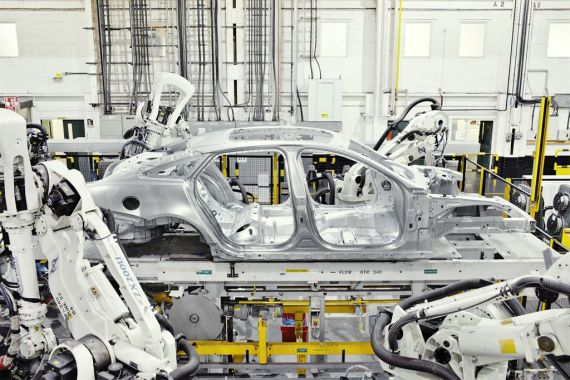Jaguar Will Take on 3 Series Segment & More With New Modular All Aluminum Architecture
Jaguar has a core competency in aluminum architecture that will be applied to their new sedan and crossover. Pictured, XJ bodies being assembled.
The mid-sized mass-market luxury car segment is defined by the BMW 3 Series. Jaguar once tried to enter that segment with the X Type, but the “mini XJ” never caught on, in part because it was derided as a badge engineered Ford Mondeo. According to Automotive News The C-X17 crossover concept revealed in Frankfurt this week is based on a new all-aluminum platform that will underpin a “range of future Jaguars”, the most important of which will be a mid-sized sedan to again take on the BMW 3 and its competitors. Jaguar has a core competency in aluminum construction and having the first all-aluminum car in the C and D segments will be a selling point for the new models. While Jaguar Land Rover’s current sales are the strongest the British car maker has had, JLR’s owners, Tata, are hoping that JLR will reach three quarters of a million units by 2020 and ultimately joining the ranks of automakers selling a million or more cars a year. To do that Jaguar needs a volume product, the most logical being a mid-sizer. With CUVs sales booming, a crossover based on the C-X17 will also help reach that volume. While differentiating between a Jaguar crossover and the Land Rover lineup will be an issue, Jaguar does say that the CUV will have some off-road capabilities.
Smaller displacement engines are seen as the auto industry’s future and JLR has invested $776 million in a new engine factory in Wolverhampton, England that will produce an all-new JLR designed four cylinder engine in both diesel and petrol versions that will likely be the standard powerplants in the vehicles based on the new platform. However, since a very large percentage of luxury cars sold in North America are currently sold with V6 engines, expect a version of Jaguar’s new V6 to be available as well. The availability of all wheel drive is critical for selling cars in the northern half of the United States, and Jaguar made a big splash this past winter about offering AWD on the XJ and XF, so you can likewise expect the new sedan to share the crossover’s AWD components.
Another current trend in the industry is modular architecture and Jaguar says that the new platform will be scalable, so it could in theory be the basis of cars the size of a BMW 5 or Mercedes-Benz E Class, or crossovers larger than the C-X17, which is about the size of an Audi Q5.
More by TTAC Staff
Latest Car Reviews
Read moreLatest Product Reviews
Read moreRecent Comments
- Analoggrotto I don't see a red car here, how blazing stupid are you people?
- Redapple2 Love the wheels
- Redapple2 Good luck to them. They used to make great cars. 510. 240Z, Sentra SE-R. Maxima. Frontier.
- Joe65688619 Under Ghosn they went through the same short-term bottom-line thinking that GM did in the 80s/90s, and they have not recovered say, to their heyday in the 50s and 60s in terms of market share and innovation. Poor design decisions (a CVT in their front-wheel drive "4-Door Sports Car", model overlap in a poorly performing segment (they never needed the Altima AND the Maxima...what they needed was one vehicle with different drivetrain, including hybrid, to compete with the Accord/Camry, and decontenting their vehicles: My 2012 QX56 (I know, not a Nissan, but the same holds for the Armada) had power rear windows in the cargo area that could vent, a glass hatch on the back door that could be opened separate from the whole liftgate (in such a tall vehicle, kinda essential if you have it in a garage and want to load the trunk without having to open the garage door to make room for the lift gate), a nice driver's side folding armrest, and a few other quality-of-life details absent from my 2018 QX80. In a competitive market this attention to detai is can be the differentiator that sell cars. Now they are caught in the middle of the market, competing more with Hyundai and Kia and selling discounted vehicles near the same price points, but losing money on them. They invested also invested a lot in niche platforms. The Leaf was one of the first full EVs, but never really evolved. They misjudged the market - luxury EVs are selling, small budget models not so much. Variable compression engines offering little in terms of real-world power or tech, let a lot of complexity that is leading to higher failure rates. Aside from the Z and GT-R (low volume models), not much forced induction (whether your a fan or not, look at what Honda did with the CR-V and Acura RDX - same chassis, slap a turbo on it, make it nicer inside, and now you can sell it as a semi-premium brand with higher markup). That said, I do believe they retain the technical and engineering capability to do far better. About time management realized they need to make smarter investments and understand their markets better.
- Kwik_Shift_Pro4X Off-road fluff on vehicles that should not be off road needs to die.


































Comments
Join the conversation
Jaguars are still thought of as being more exotic than their German, American and Japanese competitors, and I hope it stays that way. Still, it will be great to see Jaguar's take on a (successful) compact sport-sedan.
1700 new jobs for Solihull. Send the Luftwaffe. Tata gonna pull a Hyundai-Kia on the Axis.